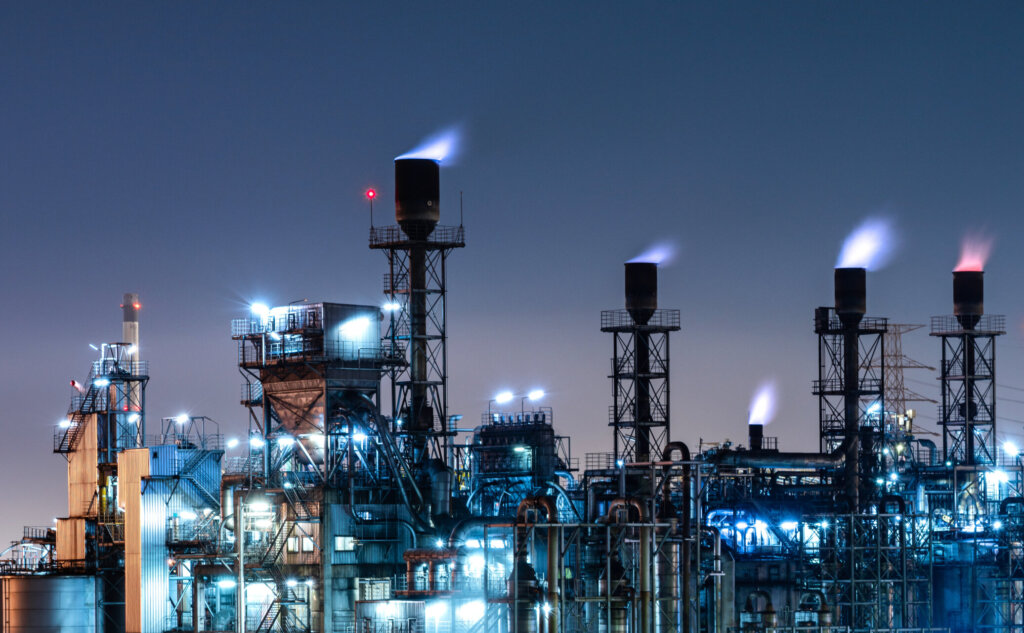Stadt- und Erdgas
METHAN, BUTAN, PROPAN, LPG – Die explosive GEFAHR
Stadt- und Erdgas, was ist das eigentlich?
Fangen wir mit Stadtgas an, das es so gar nicht mehr gibt. Es entstand aus Kohlevergasung und enthielt einen recht hohen Anteil an giftigem Kohlenmonoxid. Stadtgas gab es bis etwa Ende der 70er Jahre, in Westberlin bis Mitte der 90er. Es wurde sukzessive umgestellt auf das nicht ganz so giftige Erdgas. Dazu mussten die Verbrennungsanlagen umgebaut werden, es brauchte andere Dichtungen und Ventile. Der Name „Stadtgas“ ist in der Bevölkerung aber nach wie vor präsent, deshalb bezeichnen wir unseren Sensor für brennbare Gase noch immer als Stadt- und Erdgassensor (SE).
Erdgas, das Gas, das uns heute unsere Stadtwerke und Gasversorger zum Heizen, Warmwasserbereiten und Kochen liefern, ist ein natürlich vorkommendes Gas, das hauptsächlich als Nebenprodukt bei der Ölförderung anfällt, aber auch aus reinen Erdgasfeldern stammt, die kein Öl liefern.
Der Hauptbestandteil von Erdgas ist das leicht entzündliche Gas Methan mit bis zu 90% Volumenanteil. Weitere Stoffe sind neben Butan und Propan, verschiedene Spuren von Schwefelverbindungen, Ethan, CO2, Edelgase, Stickstoff und Wasserdampf.
Einmal gefördert wird Erdgas von giftigen und unbrauchbaren Stoffen wie Wasser, Schwefelwasserstoff und Kohlendioxid gereinigt und in unser Gasversorgungssystem eingespeist, nicht ohne es vorher wiederum mit den Schwefelverbindungen Thioether oder Alkanthiol zu versetzen, damit das Gas seinen typischen Geruch erhält, den wir ganz natürlich als Gasgeruch wahrnehmen. Ohne diese Zusatzstoffe hätte Erdgas überhaupt keinen Geruch. Jedes brennbare Gas, das verkauft wird, muss mit diesen Stoffen zur Geruchsbildung versetzt werden.
Den besten Gassensor tragen wir also bereits mitten im Gesicht: unsere Nase. Nun befindet sich unsere Nase zum Glück nicht immer genau dort, wo Gas unbeabsichtigt austreten könnte.
An den verschiedenen Verbindungen unserer Gasleitung, am Übergabepunkt, am Gashahn, am Zähler und direkt an Heizung, Herd oder Therme. Hier, meist in den sog. Heiz- und Wirtschaftsräumen (HWR), aber auch in der Küche direkt am Gasherd, kommen die „Stadt- und Erdgas Warnmelder“ von Elektrotechnik Schabus ins Spiel.
Sie stellen sofort fest, ob Gas austritt und warnen mit einem lauten durchdringenden Ton vor einem Leitungsdefekt und schalten bei Bedarf ein angeschlossenes Magnetabsperrventil ab, so dass kein weiteres Gas nachströmen kann.
Da Erdgas zum größten Teil aus dem sehr leichten Methan besteht, ist es leichter als Luft und verflüchtigt sich bei Austritt sofort nach oben. Ein GX-SE Sensor muss also im Raum oben angebracht werden, um sofort das Gas zu detektieren. Aber nicht ganz oben, sondern etwa 30 cm unterhalb der Decke, denn es gibt in den Ecken die sog. Totraumbildung. Luft, die sich in den Ecken und Kanten an der Decke befindet, kann nicht entweichen und verdrängt das Gas.
Gas aus Flaschen (Butan/Propan) ist schwerer als Luft, also wird der Sensor 15-30 cm über den Boden gesetzt.
Ab wann wird denn ausströmendes Gas gefährlich?
Es gibt die Bezeichnung „untere Explosionsgrenze“, sie wird UEG abgekürzt und in Prozent angegeben. Explosiv wird ein Gas-Luft-Gemisch erst, wenn 100% erreicht sind. Dazu muss man wissen, dass nicht die reine ausgetretene Gasmenge entscheidend ist, wie etwa bei CO leicht in ppm auszudrücken, sondern immer noch weitere Größen eine Rolle spielen. Sei es die Temperatur, die Luftfeuchtigkeit oder der Sauerstoffgehalt, denn jede Verbrennung benötigt zwingend Sauerstoff, sonst brennt nichts.
Ist die Luftfeuchtigkeit höher, ist weniger Sauerstoff vorhanden, ist die Temperatur höher, sind insgesamt auch weniger Teilchen im Raum, die miteinander reagieren können. Diese drei Größen werden von unseren SE-Sensoren berücksichtigt und in eine Spannung umgesetzt, die von den Warngeräten erfasst wird.
Nun könnte man sofort, wenn auch nur ein Molekül erfasst wird oder realistischer bei z.B. nur 3% UEG warnen, also alarmieren, doch ein solches Verhalten würde kein Kunde auf Dauer akzeptieren. Bis 5% UEG kommt ein vermeintlicher Fehlalarm häufiger vor, als man es mit einem Gasleitungsdefekt in Verbindung bringen dürfte.
Die Sensoren könnten das schon, aber wer will eine Warnung, wenn offene Farb- und Lackdosen ausgasen oder jemand mit frisch lackierten Nägeln oder frisch aufgetragenem Parfüm am Sensor vorbei geht? Lösungsmittel sind neben vielen anderen haushaltsüblichen Stoffen den Kohlenwasserstoffen des Stadt- und Erdgases nämlich sehr ähnlich und werden von den Sensoren ebenso gut erfasst.
Einige der vielen DIN-Normen, die sich mit der Detektion von Erdgas im Wohnbereich befassen, empfehlen eine Warnung spätestens bei Erreichen der 20% UEG Grenze.
Da unsere Sensoren Flüssiggas (LPG mit hohem Anteil an Butan und Propan) ebenso erfassen, haben wir uns auf eine Frühwarnstufe von 12% UEG geeinigt.
Immer rechtzeitig, damit es nicht gefährlich wird, aber ausreichend tolerant, um häufige Fehlarme zu vermeiden. Und natürlich innerhalb der Norm.


